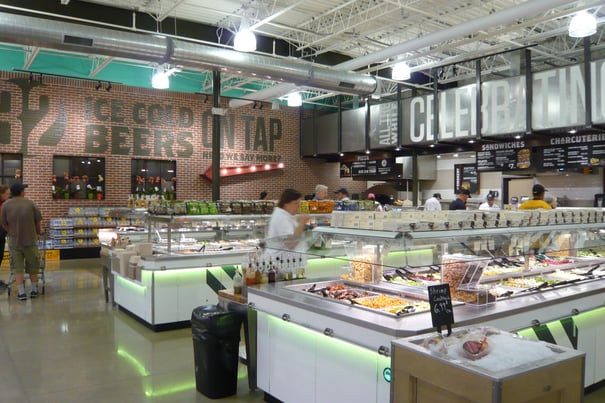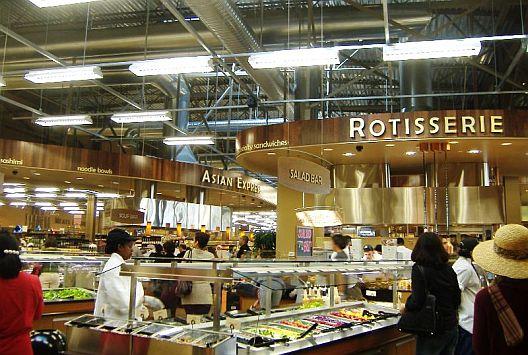Samosas, sushi, sandwiches, salads, soups—that kind of selection sounds like a trip through a burgeoning restaurant district, but really it’s just a trip through the prepared food section at 365 by Whole Foods. Such diverse offerings coupled with in-store seating have become so common the phenomenon has earned its own portmanteau—“grocerant”— to describe the line-blurring, potentially industry-shifting market.
The grocerant has proven worrisome for restaurants whose sales continue to slip, but an absolute boon for grocers. In-store dining and prepared food sales have grown 30% since 2008, and today accounts for around $19.5 billion each year. According to Forbes, 365 by Whole Foods—a nascent store but already an established grocerant heavyweight—stands to capture between 20% and 30% of restaurants’ market share over the next several years.
As Phil Lempert of supermarketguru.com observed, “The supermarket [is] trying to recapture consumers by being all things food, looking holistically at food.”
Raising the (Salad) Bar
It’s not just Whole Foods and their 365 stores getting in on the bonanza, though they certainly have lead the way, even installing a craft beer and wine bar in many of their flagship locations. But their main emphasis has been diverse offerings running the gambit of ethnic and regional cuisines. And while there are comfort foods to be found for sure (mac ‘n’ cheese, pizza) they are outnumbered by healthy, often organic, items replete with vegetarian, vegan, and gluten-free options.
And from upscale stores like New York’s tony Eataly to Texas more humble favorite H-E-B, everybody is jumping in the race, repurposing space within their stores to accommodate the shift in consumer preference. This means expanding the perimeter of the store to include hot and cold salad bars and encroaching on center-aisle real estate.
It also means broadening and diversifying your offerings. Kroger recently invested in Lucky’s grocery store and framed the announcement in grocerant terms, emphasizing Lucky’s “culinary department that showcases amazing, restaurant-quality prepared foods.” The grocery giant clearly intends to expand its prepared food options and is relying on strategic partnerships to develop them and to roll them out.
And even stores that don’t technically qualify as grocerants because they lack in-store seating (think: Trader Joe’s) still get crowded at lunch time as students and local employees peruse their prepared food perimeter.

“Give the Millennials What they Want”
As with most industry-shaping trends these days, millennials seem to be leading the way. We see two trends at work.
1) A value-conscious food culture has developed among the generation, affectionately called “foodies.” Millennials, Lempert notes, “are very passionate about food, and because of poor-paying jobs and living at home and so on, they were able to gravitate towards food as an affordable, fun way to develop community.” Indeed, the economic crises that framed the generation’s entrance into the job and housing market have consequently lowered their food budget, leading them to shun traditional dining options, but to also build community around one of life’s necessities: everybody has to eat.
2) Convenience and health are top priorities among millennials who have grown accustomed to on-demand consumer culture. With restaurants proving too pricey and fast food too unhealthy millennial shoppers have turned to grocery stores. “If I had the time to actually cook, I’d just get groceries,” offered Patrick Wong, a 27-year-old professional who often turns to the prepared foods section. “It’s a combination of laziness and convenience.”
As David Portalatin of the NPD Group promised “Give the millennials what they want—fresh, healthier fare and a decent price—and they will come.”


